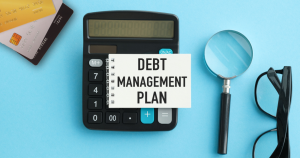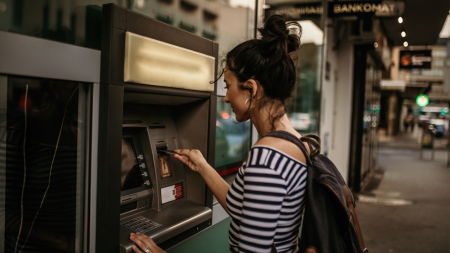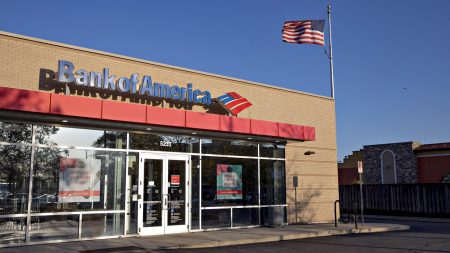- An overdraft fee may be charged when a bank temporarily covers transactions that would otherwise overdraw your account.
- An NSF fee is charged by some banks when they decline a payment or the cashing of a check that would result in a negative balance.
- Bankrate’s 2024 Checking Account Survey found the average overdraft fee to be $27.08, and the average NSF fee to be $17.72.
Anyone who has spent more money than what’s available in their checking account has likely been charged with either an overdraft fee or a nonsufficient funds (NSF) fee. Many believe the two terms are synonymous, yet there are significant differences.
While an overdraft fee may result when a bank covers a transaction that would have overdrawn your account, an NSF fee may be charged when a bank declines a payment or a check that would have brought the account into the red.
Let’s take a look at the main differences between overdraft and NSF fees, as well as ways you can avoid them.
What is an overdraft fee?
An overdraft fee is often charged by a bank when it allows transactions to go through that would otherwise have overdrawn your account. It can be viewed as a temporary loan from the bank, with the customer expected to pay back the amount the bank covered as well as the overdraft fee.
Overdraft fees can be significant, but some consumers prefer them over having a transaction simply denied. It’s best to take steps to avoid overdraft fees, such as signing up for balance alerts and regularly checking your available balance, as well as being aware of what your bank charges per fee.
How much do overdraft fees cost?
The average overdraft fee in 2024 was $27.08, according to Bankrate’s Checking and ATM Fee Survey. This was up slightly from $26.61 in 2023, and it marked the first time this average didn’t decrease since 2021. Overdraft fees were charged by 94 percent of checking accounts surveyed by Bankrate last year.
Many banks impose limits on the number of overdraft fees they will charge to an account in a single day. For example, a bank’s policy may be to charge a customer a maximum of three such fees per day. If the bank then allows four of a customer’s transactions to clear on an overdrawn account in one day, the customer will only be charged three fees that day.
Example of an overdraft fee
Suppose your account has a balance of $75, and you make a $100 debit card transaction for an expense that comes up, such as a car repair. The bank may cover that extra $25 and allow the transaction to go through. In turn, it charges you its standard overdraft fee — let’s say it’s $30 — and also expects you to pay back the $25 that has overdrawn your account. In such a case, you’ll need to fund the account with $55 to cover the fee and the remainder of the car repair charge.
Banks generally require you to promptly bring an overdrawn account to a positive balance, and they may eventually close an account that hasn’t been returned to a positive balance. This timeframe can vary among banks, and you should check with your financial institution as to its policy.
What is an NSF fee?
An NSF fee is commonly charged by banks when an account lacks the funds needed to cover a transaction, and the bank doesn’t allow the transaction to go through. The result may be in the form of bounced checks or denied electronic bill payments.
How much do NSF fees cost?
The average NSF fee was $17.72 in 2024, which was down 11 percent from the previous year and also the lowest since Bankrate began its annual checking account fee survey in 1998.
While NSF fees are generally on the decline, it’s worth noting that they’re still commonly charged. In fact, Bankrate’s survey found about one-third of accounts (36 percent) don’t charge any NSF fee.
Example of an NSF fee
Say you write a check to your landlord for $600, yet your checking account only has a balance of $500. When your landlord attempts to cash the check, the bank doesn’t allow the check to go through and charges you an NSF fee as a result.
NSF fees may also apply to electronic payments. Suppose your $100 car insurance payment is debited from your account every month, and you only have $50 in the account on the day the automatic payment is to be made. Your bank may deny the transaction and charge you an NSF fee.
In addition to your being hit with an NSF fee from the bank, having bounced checks and rejected electronic payments can cause you to receive returned check fees, late fees or interest charges from the service provider or credit card company you were attempting to pay.
Overdraft fees vs. NSF fees
The following chart compares overdraft fees and NSF fees, and lists the circumstances under which banks may charge them:
| Average fee as of 2024 | Transaction allowed to clear? | Details | |
|---|---|---|---|
| Overdraft fees | $27.08 | Yes | The bank covers a transaction that overdraws an account, and a fee is assessed. The customer is expected to pay back the fee as well as the money loaned from the bank. |
| NSF fees | $17.72 | No | The bank denies a transaction that would otherwise overdraw the account, which can result in bounced checks or declined electronic payments. A fee is assessed by the bank. |
Ways to avoid overdraft and NSF fees
- Overdraft protection: Overdraft protection is a bank service that automatically transfers money from a linked savings account when there’s not enough in your checking account to cover things like debit transactions, checks or electronic payments. Such transfers allow transactions to clear (when there are sufficient funds in the linked account), and you won’t be hit with overdraft or NSF fees — although some banks do assess a fee for overdraft protection transfers.
- Opting out of overdrafts: You won’t be charged for overdrafts if you tell the bank not to allow them for your account. However, opting out of overdrafts means the bank will simply deny any transactions that would bring your account into a negative balance.
- Account monitoring: Keeping close tabs on your account balance helps ensure you won’t initiate debits or other transactions that you’re not able to cover. Signing up to receive low-balance alerts from your bank can also prove useful.
- Finding a bank that doesn’t charge these fees: Some banks still allow for overdrafts but may not always charge customers for them.
Some banks, such as Wells Fargo, also provide customers with a grace period — often around 24 hours — to bring up a negative account balance before overdraft fees are assessed.
How an overdrawn account can affect your credit
When a customer doesn’t deposit money into an overdrawn account to eliminate the negative balance and cover any associated fees, the bank may eventually turn the account over to a collection agency, according to the credit bureau Experian. At this point, it can go onto your credit report.
Also, being overdrawn on an account can impact your ChexSystems report, which can result in being denied a bank account. ChexSystems is a specialty consumer reporting agency that tracks consumers’ deposit and debit history.
To avoid having an overdrawn checking account adversely impact your credit score, it’s important to pay off the negative balance as soon as possible. Having a conversation with a customer service representative can help you to understand the bank’s policy.
How much banks earn in overdraft and NSF fees
While many financial institutions have reduced or eliminated overdraft fees and NSF fees, they still generate significant revenue for many banks. In 2024, nearly $5 billion in cumulative income was earned from overdraft fees from the 10 banks that earn the most in these fees, according to the Consumer Federation of America, an association of non-profit consumer organizations.
Bottom line
Overdraft fees and NSF fees are both imposed by banks in different scenarios, with the main difference being one fee is charged when transactions are allowed to clear, while the other is levied when they’re denied. Both fees are often significant ones, so knowing how to avoid them is important in keeping your finances on track.
Read the full article here









